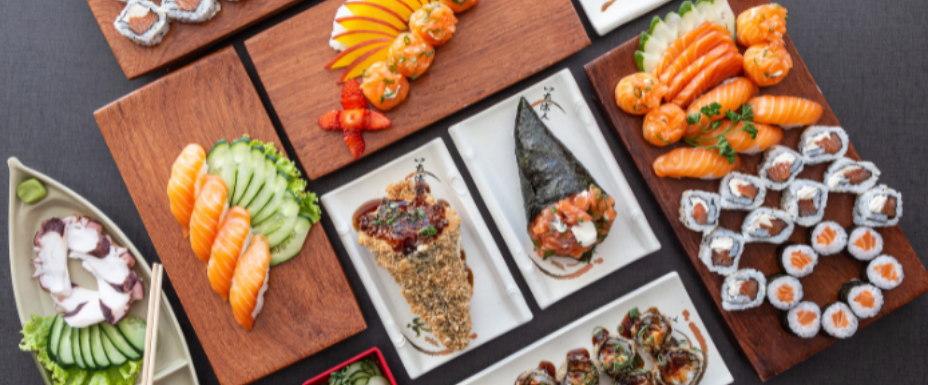You may have noticed that Japanese women tend to look younger than their age, along with having harmonious body shapes, a balanced weight, and an overall fresh and youthful look.
According to data from the World Bank, the average life expectancy of Japanese people is 84 years, compared to 81 years for the United Kingdom, 78 years for the USA, and 74 years for Mexico, Jordan, Latvia, or Bulgaria. In addition to that, Japan also has one of the lowest obesity rates of all countries on the planet.
As you may suggest, the traditional diet of the locals has a lot to do with their health and longevity. So – the Japanese diet can indeed help you lose weight, but it can also improve your overall well-being and help you live a long, healthy life.
In the paragraphs below, you can find all the important details about the traditional Japanese diet. These include the weight loss and the body sculpting potential of the diet, its basic ingredients, and its possible health benefits for people of all ages and lifestyles.
What is the Traditional Japanese Diet: Get to Know the Fundamentals
The fundamentals of the Japanese diet can be summed up as follows:
- Minimally processed foods with no excess salt, sauces, seasonings, and added flavors;
- Fresh and seasonal ingredients with a local origin and no added preservatives;
- Whole foods that reach the plate in the exact form designed by nature;
- Freshly prepared foods that hadn’t been staying in the fridge for forever;
- Little to zero content of added sugars and extracted fats;
- Low amounts of animal protein, coming mainly from seafood;
- A variety of fermented foods and pickled vegetables;
- Daily intake of green or black tea in healthy amounts;
- Small portion sizes and slow, mindful eating.
Generally, the traditional Japanese diet follows the so-called “soup and three” rule. It means that you can consume one main, protein-rich dish, accompanied by two side dishes (fresh or fermented vegetables) and a bowl of soup. Your meals can also contain small amounts of dairy products, eggs, and meat.
From a broader perspective, the traditional Japanese diet is heavily influenced by the “eat with your eyes” principle. Put shortly, it means taking your time to decorate your plate, make it look special, and experience food as a pleasurable ritual instead of a survival trick to keep you on the go.
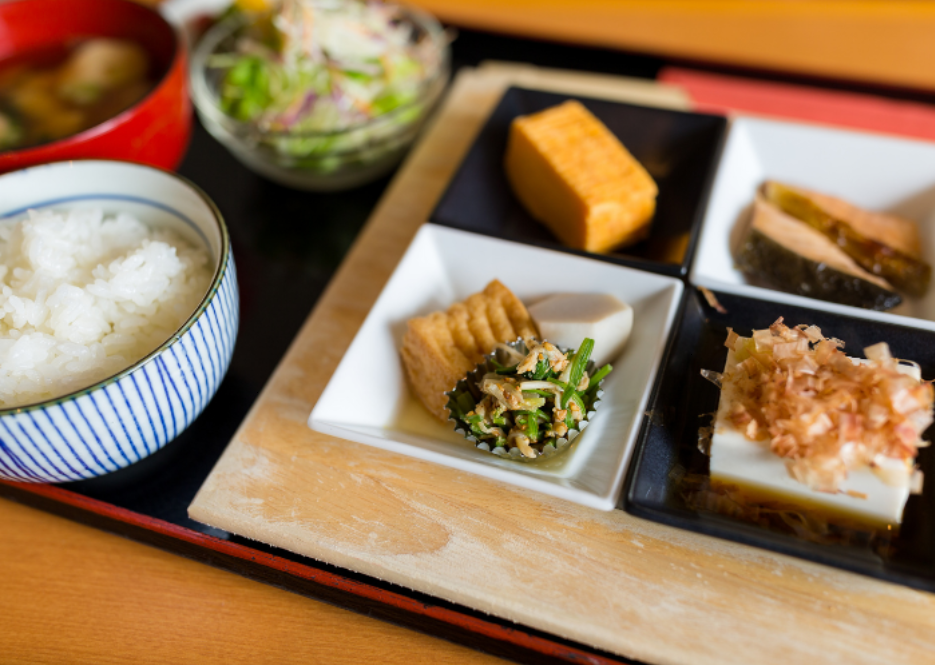
How to Follow the Traditional Japanese Diet?
First and foremost – following the Japanese diet is not generally considered a strategy for rapid and momentary weight loss. Instead, it is a lifestyle choice and a general philosophy toward food consumption, where natural, seasonal, and minimally processed foods are preferred in the long term.
When deciding to follow this diet, you will never have to stay hungry or heavily limit the amounts of food you take. You will only have to mind the types of bites on your plate, making sure they follow the general rules described above.
This being said, your typical Japanese feeding round can include:
- A bowl of soup with seaweeds, seafood, fresh or cooked vegetables, noodles, or tofu;
- A main dish: mainly fish, seafood, or natto with occasional small amounts of poultry or eggs;
- Small side dishes: greens, fruits, and vegetables that can be raw, pickled, steamed, or boiled;
- Staple food: rice, noodles, ramen, or another source of carbs that’s preferably boiled and contains no added fats.
- An unsweetened beverage: a cup of hot or cold green tea or another local herbal tea traditional for your country.
You can have three such servings for the day, with mostly no snacks or bites between them.
All of your meals shall be small in size and not consumed in a hurry. As long as you follow the “quality over quantity” principle, you can hardly go wrong – even if you step aside from your Japanese diet plan every now and then.
In addition, you are advised to increase your water intake between meals to at least 8 cups per day. This will help you stay hydrated, flush out the toxins from your body, and reduce any potential bloating.
As a result, you will get the perfect definition of functional nutrition with no calorie excess and no risk of developing any micro or macronutrient deficiency. And – of course – you will love the results you’ll soon begin to see in the mirror.
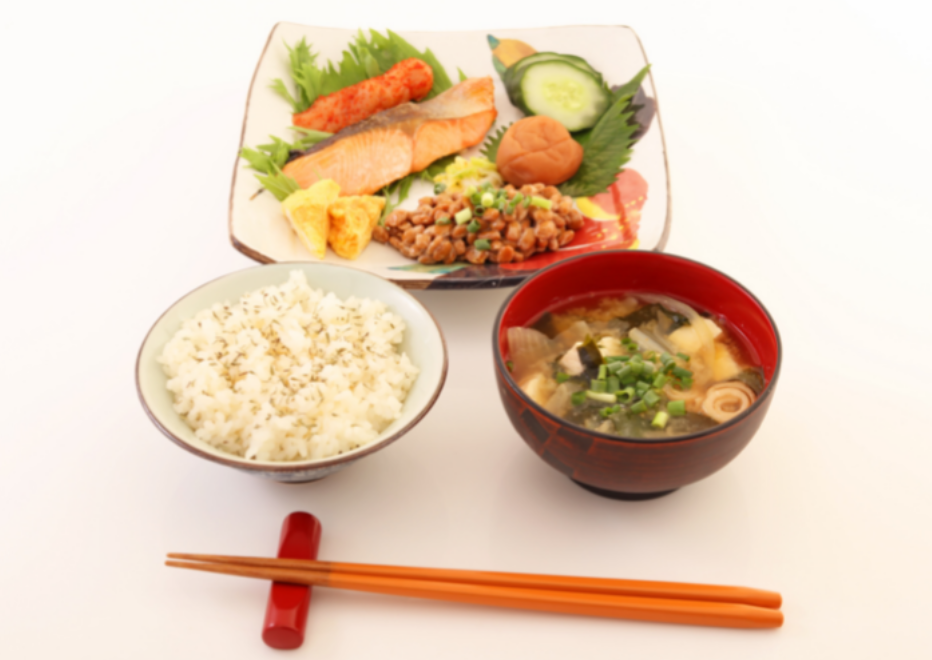
Potential Health Benefits of the Traditional Japanese Diet
To lose weight is one thing, but to stay healthy and energized while doing so is a different story. The best thing about the traditional diet of the Japanese is that it is not artificially designed to promote weight loss. On the contrary – it is a millennia-old eating habit pattern that is proven to promote good health, balanced weight, and a prolonged lifespan.
Along with saying goodbye to excess fat and high body mass index, the Japanese diet can also improve your general health in the following ways:
Promoting Cellular Health
Seaweeds, seafood, leafy greens, and green tea will often be on your table as a part of the Japanese diet. All of them are powerful antioxidants, shown to protect the cells from the effects of free radicals.
As a result, you will suffer less cellular damage in virtually all organs and systems of your body, thus staying fresh, healthy, beautiful, and youthful.
Improving Digestion
The Japanese diet is – first of all – very rich in probiotics, coming naturally as a part of the lactic acid fermentation of foods. All pickled products will support your healthy gut microbiome, thus improving your immune response, digestion, and absorption of nutrients.
To further “feed” the good bacteria in your gut, your Japanese meal plan will provide all the needed prebiotics from fibers and wholegrain foods. Ultimately, you will enjoy proper peristalsis, and you will be one step closer to the flat tummy you’ve been dreaming about.
Protecting Against Heart Disease
The mere reduction of salt and sugar to the minimum is a good enough step towards good heart health, and it is just the beginning. The Japanese diet actually contains many foods shown to reduce the risk of cardiovascular diseases – including fish, seaweeds, green tea, soy, fresh fruits, and seasonal vegetables.
Consuming less processed meats and animal protein is also beneficial for your heart and reduces your LDL (bad) cholesterol levels.
Reducing The Risk of Obesity
Following the principles of the Japanese diet is basically a guarantee for maintaining a balanced weight in the long term. Fresh, raw, seasonal, and whole foods won’t add excess calories to your energy balance, and avoiding processed products is also a game-changer.
This diet can help you reduce the fat in your body without losing muscle – especially when combined with healthy physical activity and easy to perform daily exercises.
And Much More
The traditional Japanese diet is naturally rich in precious nutrients that contribute to reaching and keeping your ideal health. These include calcium, magnesium, potassium, iron, and the entire vitamin palette found in fresh fruits and vegetables.
As a result, following the Japanese diet as a lifestyle choice is shown to reduce the risk of different chronic and degenerative diseases such as:
- Type 2 diabetes
- Alzheimer’s disease
- Parkinson’s disease
- Colorectal cancer
- Autoimmune diseases, etc.
Of course, you can’t consider any diet to be a magical all-in-one solution for every health issue out there. And still – you can think of it as the first and most crucial step towards respecting your body and its needs.
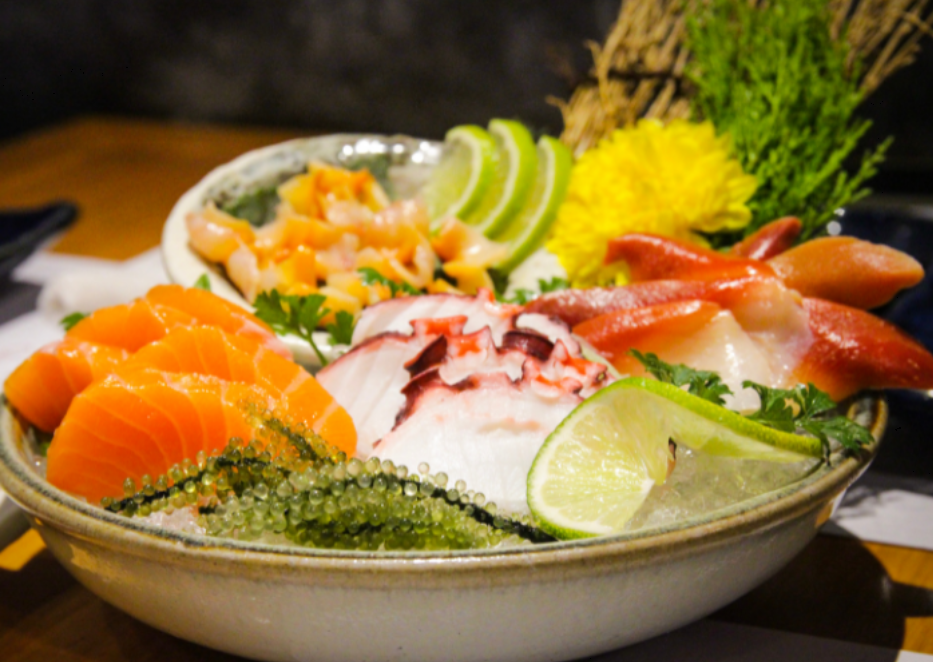
Foods to Eat On a Japanese Diet for Weight Loss
It’s not essential to switch to an all-things-Japanese eating plan if that will cost you too much time and effort. In fact, the Japanese diet can include many products that are easy to find in the nearest grocery store, and you can adjust them to your preferences.
For example, you can pick and combine the following foods:
- All types of fruits and vegetables, typical for the country you’re currently based in.
- All types of seafood, including fish, mussels, squids, shrimps, seaweeds, and algae.
- Soy foods such as damame, miso, soy sauce, tofu, or tamari.
- Rice or noodles, prepared with no added fats and served with vegetable broth.
- Herbal beverages – mostly green tea and kombucha, but also every other herbal tea you’d like.
Of course, you’re also welcome to add sushi, tempura, udon, miso soup, and all other traditional Japanese bites to your healthy weight-loss plan.
Just keep in mind that all products you buy need to be fresh, seasonal, and properly prepared – with no extra fat, no excess amounts of seasonings, and definitely no large portions.
Foods to Limit or Avoid During the Japanese Diet
As we already mentioned above, the Japanese diet promotes the exclusion of occasional snacks between the three daily meals. This automatically means that foods like popcorn, chips, crackers, packed candies, and biscuits are out of the game.
Except for the very obvious no-no’s, the Japanese diet includes minimum to no amounts of the following groups of foods:
- Processed sugar: sugary drinks, waffles, sweetened cereals, etc.
- White bread and dough foods: hamburgers, pizza, white bread, sandwiches, etc.
- Extracted fats: vegetable and cooking oils, fatty sauces and dressings, etc.
- Dairy products: milk, yogurt, yellow and white cheese, curd, cottage cheese, etc.
- Meats: pork, beef, lamb, chicken, turkey, etc.
You can consume hard-boiled eggs in moderation, and poultry can be occasionally added to the meal plan, but not as an everyday food. Generally, animal protein is substituted with its plant-based alternatives.
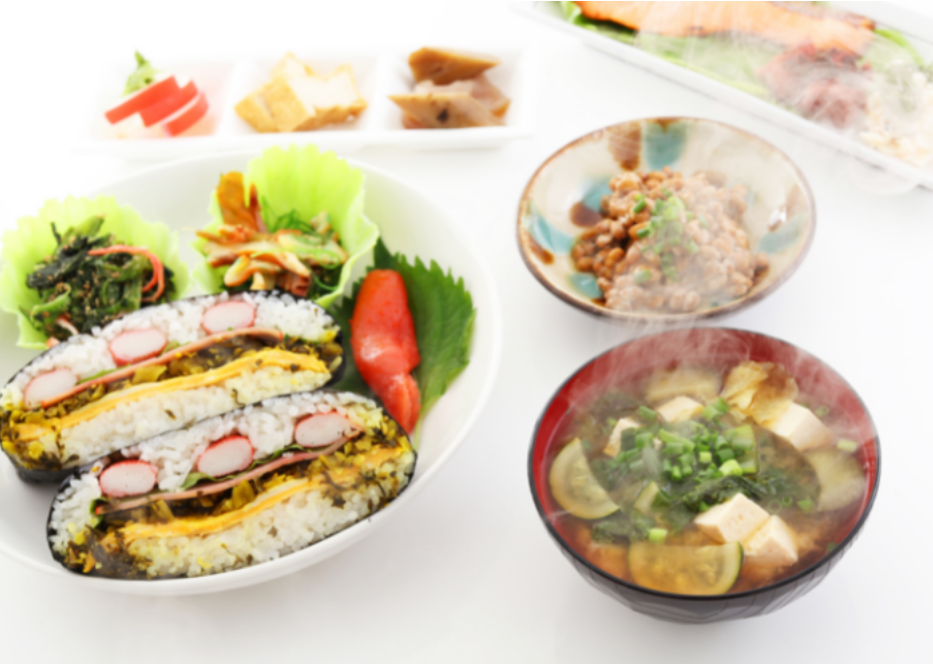
Sample Menu When Following the Traditional Japanese Diet
A sample three-day menu, to begin with, can look like this:
Day 1
Breakfast: seaweed soup, boiled rice, natto, and fresh seasonal salad.
Lunch: noodles in vegetable broth, smoked salmon, a seasonal salad, and steamed vegetables.
Dinner: miso soup, grilled squids, edamame, and pickled vegetables.
Day 2
Breakfast: ramen soup, boiled rice, and fresh seasonal fruits.
Lunch: grilled tuna, grilled vegetables, and a fresh tomato juice.
Dinner: noppe soup, steamed fish, seaweed salad, and pickled vegetables.
Day 3
Breakfast: black tea and seasonal fruits
Lunch: sushi, boiled carrots with lemon juice, and pickled ginger.
Dinner: shiitake mushroom soup, vegetable tempura, and steamed vegetables.
Managing your meals can be challenging in the beginning. But once you get used to the fundamentals of the Japanese diet, you will easily substitute ingredients and develop your own menu according to your taste.
At the end of the day, your diet and food shall ever be harmonizing with your personal preferences, so achieving healthy weight loss and good health can feel easy and effortless.

